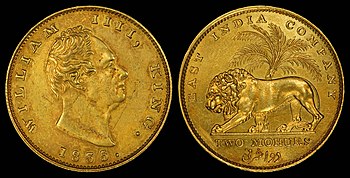|
Featured picture tools: |
These featured pictures, as scheduled below, appeared as the picture of the day (POTD) on the English Wikipedia's Main Page in December 2020. Individual sections for each day on this page can be linked to with the day number as the anchor name (e.g. [[Wikipedia:Picture of the day/December 2020#1]] for December 1).
You can add an automatically updating POTD template to your user page using {{Pic of the day}} (version with blurb) or {{POTD}} (version without blurb). For instructions on how to make custom POTD layouts, see Wikipedia:Picture of the day.Purge server cache
December 1
|
The Portrait of Cardinal Niccolò Albergati is an oil-on-oak-panel painting by the Early Netherlandish painter Jan van Eyck, dating to the 1430s. It is of considerable interest to art historians because van Eyck's preliminary drawing survives. The work depicts Niccolò Albergati, an Italian cardinal and a diplomat working under Pope Martin V, as a visibly ageing cleric, his face seamed with deep lines below the eyes; it is accompanied by notes on the colours to be used in the final painting. A comparison between this drawing and the portrait shows that van Eyck changed several details, such as the depth of the shoulders, the lower curve of the nose, the depth of the mouth and the size of the ear. The finished painting hangs at the Kunsthistorisches Museum, Vienna, while the drawing is in the collection of the Staatliche Kunstsammlungen Dresden. Artwork credit: Jan van Eyck
Recently featured:
|
December 2
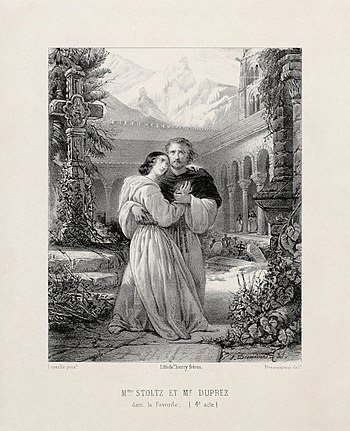
|
La favorite (The Favourite) is a grand opera in four acts by Gaetano Donizetti to a French-language libretto by Alphonse Royer and Gustave Vaëz, based on the play Le comte de Comminges by Baculard d'Arnaud. The plot revolves around a love triangle involving Alphonse (Alfonso XI), King of Castile; his mistress Léonor (Leonora), the titular favourite; and her lover Fernand (Fernando). The story unfolds against the background of Moorish Spain and power struggles between church and state. The opera premiered in Paris in 1840, with further performances being staged in England, Italy, the United States and elsewhere. This lithograph, forming the frontispiece to the first-edition vocal score of La favorite, depicts Rosine Stoltz as Léonor and Gilbert Duprez as Fernand. Lithograph credit: Émile Desmaisons, after François-Gabriel Lépaulle; restored by Adam Cuerden
Recently featured:
|
December 3
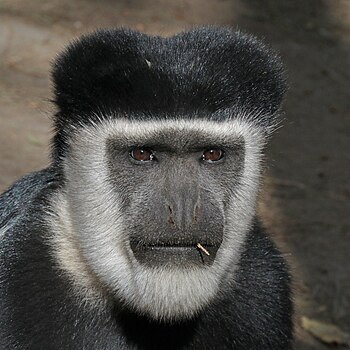
|
The mantled guereza (Colobus guereza) is a species of Old World monkey native to much of western central and eastern Africa. Although its colouring is somewhat variable across its range, it has a distinctive pelage which is mostly black, with a white facial disc and long white fringes of silky hair along the sides of its body. The tail is long and ends in a white tuft of variable length. It is a diurnal, mostly arboreal monkey, with groups moving through the canopy feeding mainly on leaves, with some fruits and other food items. This male of the subspecies C. g. guereza, also known as the Omo River guereza or the Abyssinian black-and-white colobus, was photographed in Amora Gedel Park in Awasa, Ethiopia. Photograph credit: Charles J. Sharp
Recently featured:
|
December 4

|
Santa Maria della Vittoria is a Catholic titular church dedicated to the Virgin Mary in Rome, Italy. Completed in 1620, it is the only structure designed and completed by the early Baroque architect Carlo Maderno. The interior, shown here, has a single wide nave under a low segmental vault, with three interconnecting side chapels behind arches separated by colossal Corinthian pilasters with gilded capitals that support an enriched entablature. Contrasting marble revetments are enriched with white and gilded stucco angels and putti in full relief. Photograph credit: Livioandronico2013
Recently featured:
|
December 5

|
Martin Van Buren (December 5, 1782 – July 24, 1862) was an American statesman who served as the eighth president of the United States from 1837 to 1841. A founder of the Democratic Party, he won the 1836 presidential election with the endorsement of popular outgoing President Andrew Jackson and the organizational strength of his party. He lost his 1840 reelection bid to the Whig Party nominee William Henry Harrison, thanks in part to the poor economic conditions surrounding the Panic of 1837, a financial crisis that touched off a major depression. This line engraving of Van Buren was produced around 1902 by the Department of the Treasury's Bureau of Engraving and Printing (BEP) as part of a BEP presentation album of the first 26 presidents. Engraving credit: Bureau of Engraving and Printing; restored by Andrew Shiva
Recently featured:
|
December 6

|
The Day Dream is an oil-on-canvas painting created by the English Pre-Raphaelite poet and artist Dante Gabriel Rossetti in 1880. His model was Jane Morris, with whom he had a complex relationship, and who "consumed and obsessed him in paint, poetry, and life". She is shown in this painting in a flowing green silk dress, surrounded by the dark, shady foliage of a sycamore tree. Her book forgotten, she is immersed in her daydreams, while a sprig of honeysuckle dangles from her fingers, perhaps as a token of love. The painting is in the collection of the Victoria and Albert Museum in London. Painting credit: Dante Gabriel Rossetti
Recently featured:
|
December 7

|
This historical depiction of the coat of arms of Delaware was illustrated by American engraver Henry Mitchell in State Arms of the Union, published in 1876 by Louis Prang. A Mid-Atlantic state, Delaware ratified the Constitution of the United States on December 7, 1787, becoming the first state to do so. The shield depicts a wheat sheaf, a corn cob and an ox, representing the importance of agriculture to the state's economy, with the blue horizontal stripe referring to the Delaware River. The ship in the crest is a symbol of the state's extensive coastal commerce, while the shield's supporters are a farmer with a hoe (again representing the central role of farming to the state) and a militiaman (recognizing the crucial role of the citizen-soldier to the maintenance of American liberties). The motto, Liberty and independence, was provided by the Society of the Cincinnati. Illustration credit: Henry Mitchell; restored by Andrew Shiva
Recently featured:
|
December 8

|
The golden-headed cisticola (Cisticola exilis) is a species of warbler in the family Cisticolidae, found in Asia and Australia. An unobtrusive bird, it forages for invertebrates, such as insects and small slugs, near the ground, but supplements its diet with grass seeds. Both sexes construct the rounded nest with a side entrance in a grass tussock or among tangled herbage. Built of green leaves and fine grasses and lined with soft plant down, it is stitched together with cobweb silk and camouflaged on the outside with further herbage. The female incubates the eggs and the male drives off intruders, but despite this concealment and care, only 32 per cent of the eggs successfully hatch. This golden-headed cisticola was photographed near Cornwallis, New South Wales, in Australia. Photograph credit: John Harrison
Recently featured:
|
December 9

|
Wat Arun is a Buddhist temple in Bangkok, Thailand. The temple derives its name from the Hindu god Aruna. This photograph shows the sculptures of two mythical giant demons, Thotsakan (green-skinned) and Sahatsadecha (white-skinned), guarding the eastern gate of the temple's ordination hall, a building designated for the performance of upasampadā, the Buddhist ordination ritual, and other ritual ceremonies. The entrance of the ordination hall has a roof with a central spire, decorated in coloured ceramic and stucco and sheathed in coloured china. Photograph credit: BerryJ
Recently featured:
|
December 10
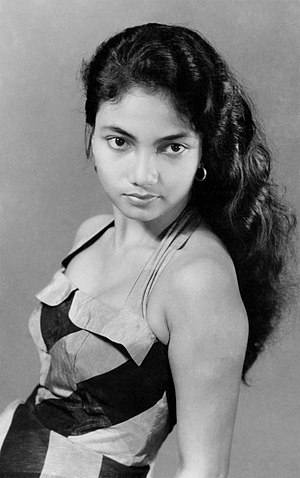
|
Lies Noor (c. 1938 – 1961) was an Indonesian actress. She first appeared on film in Pulang (Homecoming) in 1952, while she was still at school. She rose in popularity with a string of successful films, and was able to command high fees for her roles. In the mid-1950s, having married and had a child, she took a break from her career to care full-time for her son. After returning to acting in 1960, however, she developed encephalitis the next year and died in hospital two days later. This photograph of Noor was taken around 1956. Photograph credit: Djakartawood Studio; restored by Chris Woodrich
Recently featured:
|
December 11
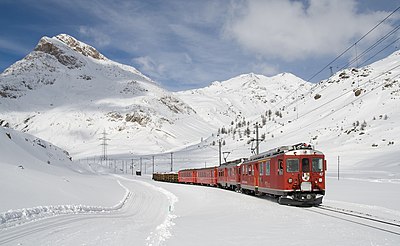
|
The Bernina railway is a single-track, metre-gauge railway line forming part of the Rhaetian Railway. It links the spa resort of St. Moritz, in the canton of Graubünden, Switzerland, with the town of Tirano, in the Province of Sondrio, Italy. This photograph shows a train near the top of the Bernina Pass at an elevation of more than 2,100 metres (6,900 ft). The two ABe 4/4 multiple units have excess power with only two passenger cars, so some freight is carried along at the rear of the train. Photograph credit: David Gubler
Recently featured:
|
December 12
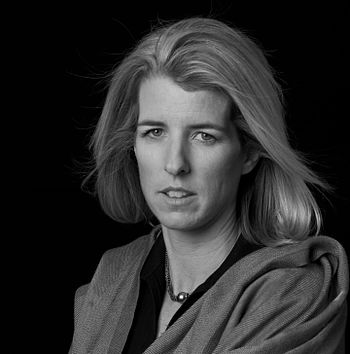
|
Rory Kennedy (born December 12, 1968) is an American documentary filmmaker and the youngest child of U.S. senator Robert Kennedy and Ethel Skakel. Born six months after the assassination of her father, her life has seen many tragedies. As a director and producer, she has made documentary films that center on social issues such as addiction, nuclear radiation, the treatment of prisoners of war, and the politics of the Mexican border fence. Her films have been featured on many TV networks, and her 2014 documentary Last Days in Vietnam was nominated for an Academy Award. Photograph credit: Lyndie Benson
Recently featured:
|
December 13
|
The mohur is a gold coin that was formerly minted by several governments, including those of British India. It was usually equivalent in value to fifteen silver rupees. Gold mohurs issued by the British East India Company or the Crown are valuable collectors' items, and sell in auctions for high prices. The double mohur (minted between 1835 and 1918), with a value of thirty rupees, is the highest-denomination circulating coin ever issued in India. The 1835 two-mohur coin above was minted in the reign of King William IV, while the 1862 one-mohur coin below was minted in the reign of Queen Victoria; both are now part of the National Numismatic Collection at the National Museum of American History. Coin design credit: East India Company and the Calcutta Mint; photographed by Andrew Shiva
Recently featured:
|
December 14

|
Charles IV of Spain and His Family is a portrait of the royal family of Spain painted by Francisco Goya in 1800 and 1801. King Charles IV, his wife Maria Luisa of Parma, and his children and relatives are dressed in the height of contemporary fashion, lavishly adorned with jewelry and the sashes of the order of Charles III. The artist does not attempt to flatter the family; instead the group portrait is unflinchingly realist, both in detail and tone. The artist, seated at his easel, is visible in the background. The painting is in the collection of the Museo del Prado in Madrid. Painting credit: Francisco Goya
Recently featured:
|
December 15

|
|
The Haditha Dam is an earth-filled dam in Iraq, holding back the waters of the Euphrates to create Lake Qadisiyah. The area around Haditha is very arid, with a hot desert climate; the annual precipitation is about 127 millimetres (5 in), mainly occurring during the winter. This photograph, taken from the International Space Station in November 2015, shows the reservoir at a low water level, surrounded by an expanse of dry lakebed; the Haditha Dam is visible near the top of the image. Lake Qadisiyah has a maximum water-storage capacity of 8.3 cubic kilometres (2.0 cu mi) and a maximum surface area of 500 square kilometres (190 sq mi). The associated hydroelectric power station is capable of generating 660 megawatts of electricity, and outlets at the foot of the dam can discharge 3,000 cubic metres (110,000 cu ft) of water per second for irrigation. Photograph credit: NASA, Kjell N. Lindgren
Recently featured:
|
December 16

|
Camille Saint-Saëns (9 October 1835 – 16 December 1921) was a French composer, organist, conductor and pianist of the Romantic era. He was a musical prodigy, making his concert debut at the age of ten, and was still performing nearly seven decades later, giving what he intended to be his farewell concert as a pianist in Paris in 1913. Saint-Saëns's retirement was soon in abeyance as a result of World War I, during which he gave many performances in France and elsewhere, raising money for war charities. In November 1921, he gave a recital before a large invited audience, where it was remarked that his playing was as vivid and precise as ever; but he died unexpectedly of a heart attack the following month while in Algiers. This photograph of Saint-Saëns by Pierre Petit was taken in 1900. Photograph credit: Pierre Petit; restored by Adam Cuerden
Recently featured:
|
December 17

|
Chelsea Manning (born December 17, 1987) is an American activist and whistleblower. She is a former United States Army soldier who was convicted by court-martial in July 2013 of violations of the Espionage Act and other offenses after having disclosed to WikiLeaks nearly 750,000 classified, or unclassified but sensitive, military and diplomatic documents. Manning was released after nearly seven years of confinement, but was further detained in 2019 for refusing to testify before a grand jury investigating WikiLeaks founder Julian Assange. A trans woman, Manning stated in 2013 that she had had a female gender identity since childhood. Photograph credit: Tim Travers Hawkins
Recently featured:
|
December 18

|
|
English Gothic architecture is an architectural style that flourished in England from the late 12th to the mid-16th century. The style was most prominently used in the construction of cathedrals and churches. The defining features of Gothic architecture are pointed arches, rib vaults, buttresses, and extensive use of stained glass. This photograph shows the Gothic cloisters at Gloucester Cathedral, which have the earliest surviving fan vaults in the country, designed between 1351 and 1377. These cloisters were used as a backdrop in three of the Harry Potter films. Photograph credit: Christopher J. T. Cherrington
Recently featured:
|
December 19

|
NGC 6357 is a diffuse nebula in the constellation Scorpius. This composite image of the nebula contains X-ray data from the Chandra X-ray Observatory and the ROSAT telescope (purple), infrared data from the Spitzer Space Telescope (orange), and optical data from the SuperCosmos Sky Survey (blue). Radiation from hot, young stars is energizing the cooler gas in the clouds that surround them. Often known as the Lobster Nebula, the astronomical object has also been termed the Madokami Nebula by fans of the anime Madoka Magica due to its supposed resemblance to the main character. Scientists at the Midcourse Space Experiment prefer the name War and Peace Nebula, because the bright, western part resembles a dove, while the eastern part looks like a skull in infrared images. Photograph credit: NASA
Recently featured:
|
December 20

|
The violet-backed starling (Cinnyricinclus leucogaster) is a relatively small species of starling, common in most of sub-Saharan Africa. It is strongly sexually dimorphic, with the male's iridescent violet plumage contrasting with the heavily streaked brown female. A bird of open woodland, clearings and gallery forests, it feeds in the treetops, with its diet including fruits, seeds and insects. It nests in tree cavities, with green leaves and dung having been recorded as nesting materials. The female incubates the clutch of two to four eggs, and the male helps rear the young until they fledge about three weeks after hatching. This male violet-backed starling, of the subspecies C. l. verreauxi, was photographed in Damaraland, Namibia. Photograph credit: Charles J. Sharp
Recently featured:
|
December 21
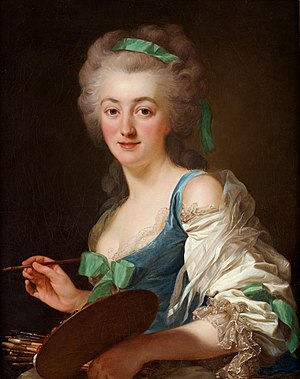
|
Anne Vallayer-Coster (21 December 1744 – 28 February 1818) was an 18th-century French painter, best known for her still-life works. When she was 26, she was admitted to the prestigious Académie royale de peinture et de sculpture; Vallayer-Coster was one of only four women to be accepted into the Académie before the French Revolution, in a period when men dominated the profession. By 1780, she had come under the patronage of Marie Antoinette, after which her career flourished. This 1783 oil-on-canvas portrait, showing Vallayer-Coster at work, is by the Swedish painter Alexander Roslin. The painting is in the collection of the Crocker Art Museum in Sacramento, California. Painting credit: Alexander Roslin
Recently featured:
|
December 22
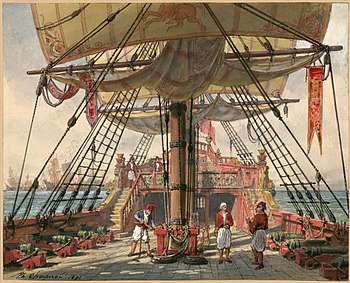
|
Haydée is an opéra comique by the French composer Daniel Auber, first performed by the Théâtre Royal de l'Opéra-Comique at the Salle Favart in Paris on 28 December 1847. The libretto, based on a short story by Prosper Mérimée, was written by Eugène Scribe. The plot is set during the 16th-century wars between the Republic of Venice and the Ottoman Empire, and involves a naval commander with a guilty secret, his ward, his slave girl, a handsome captain and a villainous spy. After much confusion and intrigue, everything ends happily for the main protagonists. This illustration shows Philippe Chaperon's set design for the second act of a 1891 Opéra-Comique performance of Haydée at the Théâtre de la Ville in Paris. Set design and illustration credit: Philippe Chaperon; restored by Adam Cuerden
Recently featured:
|
December 23
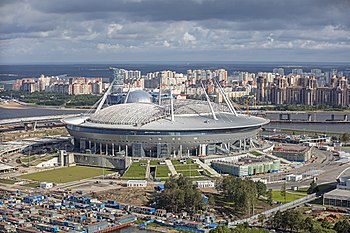
|
The Krestovsky Stadium is the home ground of FC Zenit Saint Petersburg. Photographed here in 2016, when construction was nearing completion, it is situated on Krestovsky Island in the Russian city of Saint Petersburg. It was opened in 2017 as a venue for the 2017 FIFA Confederations Cup, and hosted the final, in which Germany beat Chile 1–0. It was one of the venues for the 2018 FIFA World Cup the following year. Among other features, it has a retractable roof, and is equipped with a video-surveillance and identification system, as well as security-alarm, fire-alarm and robotic fire-extinguishing systems. The stadium's seating capacity is 67,800. Photograph credit: Andrew Shiva
Recently featured:
|
December 24

|
Ambrosius Bosschaert (1573–1621) was a Flemish-born Dutch still-life painter and art dealer. A rising interest in botany and a passion for flowers led to an increase in still-life paintings of flowers at the end of the 1500s in the Netherlands and Germany, and Bosschaert was the first great Dutch specialist in the genre. In this oil-on-copper painting, butterflies, a dragonfly, a bumblebee and a caterpillar are nestled among roses, forget-me-nots, lilies-of-the-valley, tulips and other flowers. The painting is in the collection of the J. Paul Getty Museum in Los Angeles, California. Painting credit: Ambrosius Bosschaert
Recently featured:
|
December 25

|
Pope Pius VI (25 December 1717 – 29 August 1799) was the head of the Roman Catholic Church and ruler of the Papal States from 15 February 1775 until his death in 1799. He condemned the French Revolution and the resulting suppression of the Catholic Church in France. In 1796, French troops commanded by Napoleon Bonaparte defeated the papal troops and occupied the Papal States. Refusing to renounce his temporal power, Pius was taken prisoner and transported to France. He died in exile six weeks later in Valence, having reigned for longer than any previous pope. This 1775 oil-on-panel portrait of Pius VI by the Italian painter Pompeo Batoni is in the collection of the National Gallery of Ireland. Painting credit: Pompeo Batoni
Recently featured:
|
December 26

|
|
The Arg-e Bam, in Kerman Province in southeastern Iran, is the largest adobe building in the world and a UNESCO World Heritage Site. The ancient citadel has a history dating back around two thousand years, to the Parthian Empire (248 BC – 224 AD), but most of its buildings were constructed during the Safavid dynasty. A strong earthquake on 26 December 2003 largely devastated the fortress and the nearby modern city of Bam. The Arg-e Bam, including the governor's residence, the main tower, the Four Seasons Palace and the hammam, were nearly totally destroyed; this photograph from 2016 shows the citadel partially reconstructed. Photograph credit: Diego Delso
Recently featured:
|
December 27

|
The Adoration of the Shepherds is a theme in depictions of the Nativity in which shepherds are near witnesses to the birth of Jesus; the scene is based on the biblical account in Luke 2 and has inspired many artists over the years. The nativity scene typically shows shepherds and animals in the stable at Bethlehem, surrounding Mary and the Christ Child. In this 1662 oil painting of the Adoration by the Dutch Golden Age painter Gerard van Honthorst, Jesus is the centre of attention; the infant seems to glow, illuminating the surrounding figures. The work is in the collection of the Pomeranian State Museum in Germany. Painting credit: Gerard van Honthorst
Recently featured:
|
December 28
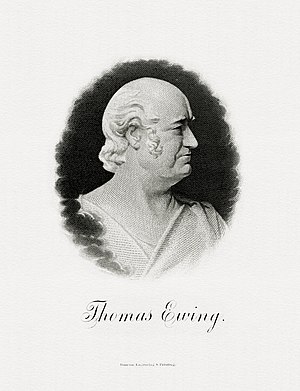
|
Thomas Ewing (December 28, 1789 – October 26, 1871) was a country lawyer from Ohio who was elected to the United States Senate in 1830 as a Whig. He later served as Secretary of the Treasury and the first Secretary of the Interior. In the latter capacity, he earned the nickname "Butcher Ewing" because he replaced so many officials with political appointees. This line engraving of Ewing was produced around 1902 by the Department of the Treasury's Bureau of Engraving and Printing (BEP) as part of a BEP presentation album of the first 42 secretaries of the treasury. Engraving credit: Bureau of Engraving and Printing; restored by Andrew Shiva
Recently featured:
|
December 29

|
The Wounded Knee Massacre was a massacre of Lakota people by soldiers of the United States Army that took place near Wounded Knee Creek, South Dakota, on December 29, 1890. In what was supposed to be a peaceful transport operation, troops of the 7th Cavalry engaged in battle with a contingent of Miniconjou and Hunkpapa Lakota, resulting in the deaths of more than 250 Lakota men, women and children, and 25 troopers. This photograph, taken three weeks after the massacre, shows Lakota corpses wrapped in blankets; the frozen bodies were subsequently collected and buried in a mass grave on a nearby hill. Photograph credit: Trager & Kuhn; restored by Lise Broer
Recently featured:
|
December 30

|
|
The llama (Lama glama) is a domesticated South American camelid, widely used as a meat and pack animal by Andean cultures since the pre-Columbian era. A full-grown llama can reach a height of 1.7 to 1.8 metres (5 ft 7 in to 5 ft 11 in) at the top of the head, and can weigh between 130 and 200 kilograms (290 and 440 lb). At birth, a baby llama (known as a cria) can weigh between 9 and 14 kilograms (20 and 31 lb). Llamas typically live for 15 to 25 years, with some individuals surviving 30 years or more. This photograph shows a dam (female llama) and her cria at Laguna Colorada in Eduardo Avaroa Andean Fauna National Reserve, Bolivia. Photograph credit: Kallerna
Recently featured:
|
December 31

|
Fervaal is an opera with a prologue and three acts by the French composer Vincent d'Indy. Fervaal is the son of a Celtic king and is destined to be the last advocate of the old gods. His mission is to save his homeland from invasion and pillage, but in doing so he must renounce love. This illustration, by the Swiss painter Carlos Schwabe, relates to the 10 May 1898 premiere of the opera at the Théâtre de l'Opéra-Comique in Paris. Here, Fervaal is depicted ascending a mountain while carrying the body of his beloved Guilhen at the end of the opera, as the pagan gods and their worshippers fade out of existence with the dawn of Christianity. Illustration credit: Carlos Schwabe; restored by Adam Cuerden
Recently featured:
|
Picture of the day archives and future dates


